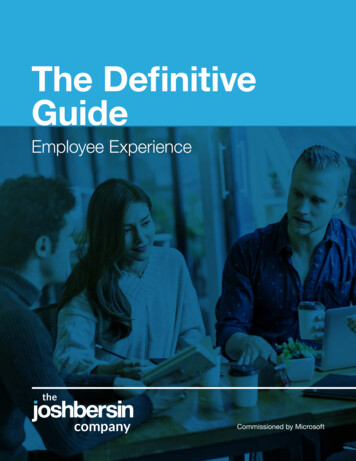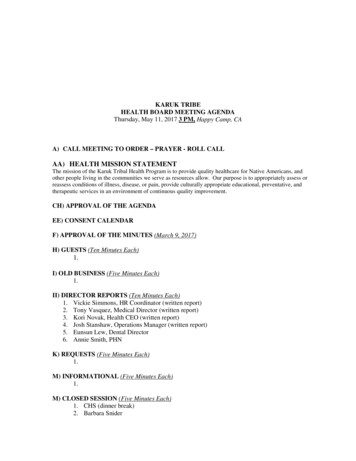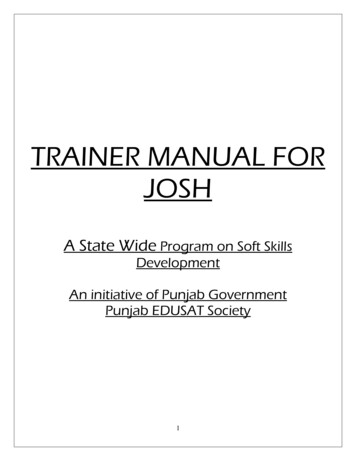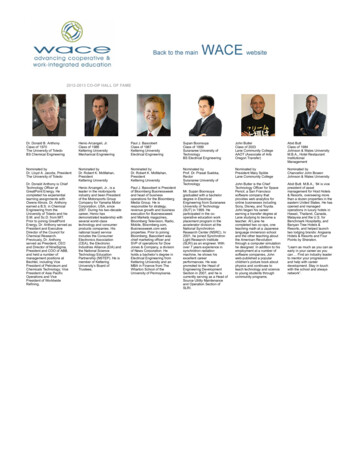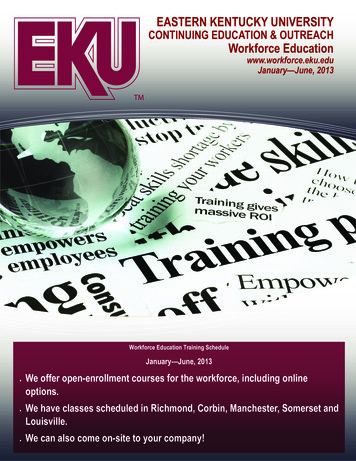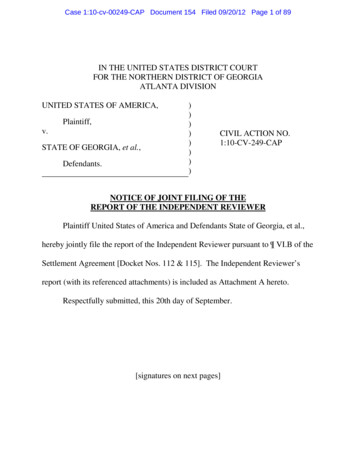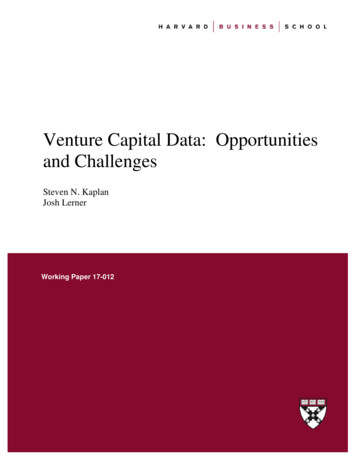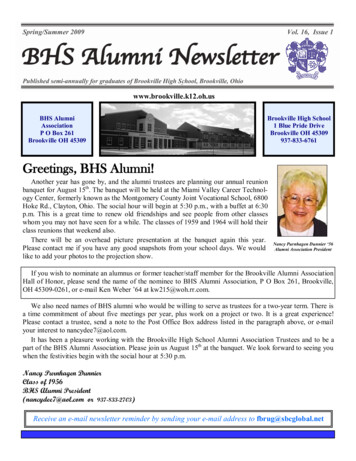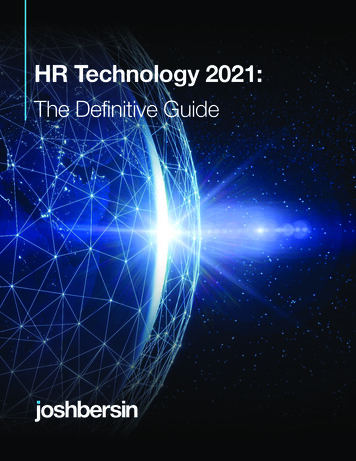
Transcription
HR Technology 2021:The Definitive Guide
IntroductionAs an industry analyst, I spend many hours every year talking with HRleaders, vendors, investors, and consultants about the ever-changingworld of HR technology. I’ve done this for over 18 years, and I loveevery minute of it. This market is fascinating, ever-changing, and vitallyimportant.My goal in writing these annual reports is to give you understanding andperspective of the current market. I do this with the belief that everyproduct, every vendor, and every solution has value. My job is not to rankor rate these solutions but rather to give you unbiased and informedinformation to make sound decisions. (Note: If you work for a solutionprovider that is missing from this report or have an opinion different thanmine, I want to hear from you.)You can keep in touch with all my research at http://www.joshbersin.com where I regularly write articles and produce lots of studies onvarious parts of the market. You can also reach me on Twitter or LinkedIn.If you have questions, please submit them through one of these channels.2HR TECHNOLOGY 2021: THE DEFINITIVE GUIDE
Contents32Introduction4The Big Reset: A Shift from HR Tech to Work Tech19The HR Tech Market Examined191. Core HR Platforms Grow and Expand292. Creating an Employee-Centric Architecture323. The Safe, Productive Workplace334. Talent Management Reinvented: A Competitive Marketplace375. Reinvented Employee Experience416. Employee Listening, Engagement, Culture Tools477. Recruitment Market Changes: AI and Data Now Lead528. Gig Work Management Is Becoming a Category549. The Talent Marketplace5710. Performance Management Tools Evolve6211. Innovation and Growth in Learning Technology7012. Wellbeing Market Explodes7413. Analytics, AI, ONA, and Natural Language Systems83Wrapping It All Up: HR Tech Integral to HR84Appendix: Background on the HR Technology MarketHR TECHNOLOGY 2021: THE DEFINITIVE GUIDE
The Big Reset: A Shift fromHR Tech to Work TechHR technology is an essential part of business today. Morethan 12.1 million employers in the U.S. alone spend over 5trillion on payroll, benefits, training, and other employeeprograms. More than a third of the workforce changesjobs every year, creating a 250 billion-plus market forrecruitment, advertisement, assessment, and interviewing.The Vastness of HR ApplicationsThe first issue to discuss is the massive spread of HRapplications into areas beyond payroll and employeeadministration. Yes, every company needs a core system ofrecord that stores employee information and a system thatmodels the company (who is in what job, who reports to whom,what level are people, their pay, benefits, schedules, andcertifications). This core HR and payroll market is over 15billion in size.The L&D marketplace is over 240 billion per year and spansBut employers need much more. Consider the vast number ofthe range from onboarding to leadership development toHR or employee applications shown at the bottom of Figure 1.technical and continuous skills programs. And the market forEverything that happens at work – from the minute you leavewellbeing, benefits, insurance, workplace tools, and workplacehome to the minute you clock out at night – is a step, stage,productivity systems is similarly large.or series of activities that can be facilitated and improvedNeedless to say, the pandemic has radically changed themarketplace. Companies of all sizes have sent their employeesby technology. In the year ahead, I see a massive convergencebetween HR tech and work tech.home and are adopting remote work, remote meetings, andThis is not to say that the functions in core systems are notremote management at scale. Technologies purchased asimportant; they are. In the core HR space alone, there areexperiments have become mission-critical, and every piece ofmore than 100 vendors. They range from payroll companiesHR technology is moving from “good to have” to “essential tolike ADP, Paychex, Paycor to mid-market solutions like UKGsurvival.”(Ultimate), Ceridian, HiBob, Gusto, Bamboo to enterpriseWhile there are many changes taking place, the biggest shiftof all is the move from HR technology to work technology.This means that everything we now buy must feel useful andimportant as a tool for getting work done.offerings like Oracle, Workday, SAP, SuccessFactors, andInfor. These vendors are all thriving to a degree (vendors thatsell to small companies did see a slowdown), but they are allperforming essential functions. And their most significantchallenges have been adding more applications and buildingsystems that are adaptive and easy to use.Figure 1: From HR Tech to Work Tech4HR TECHNOLOGY 2021: THE DEFINITIVE GUIDE
Figure 2: Evolution of HR Functions to Work TechThe big shift in 2021 is something that has been coming for aIn many ways, these tools replace the expensive, enormouslylong time: a focus on employee experience (EX). Employeescomplex employee portal that many companies have built. Thejust do not have the time, interest, or attention span to log intovendors are trying to develop single interfaces for employees –an HR system, poke around looking for the right page, and thenall to make people more productive, healthy, and connected toenter their vacation schedule. At most, they would be willing totheir peers.chat with the system – but ideally, this would be an easy-to-useapp that just fits right into existing tools at work.Suppose, for example, you are a salesperson, and you arecalling on a new prospect. How can you quickly see whatI draw this new market in the red layer in Figure 3. This layerindustry information is available? What are the deals theincludes tools for communications, surveys, case management,company has done before? Who are the experts in this market?and knowledge management and for building new workflows,And what products should you sell? Logging into the LMS willchatbots, and portals. It is clearly the hottest part of thenot help you answer any of these questions. Nor will Salesforcemarket.tell you everything you need.The big incumbent vendors in this layer include ServiceNow,Or suppose you are a delivery driver. You may want to knowMicrosoft, Workplace by Facebook; Workday, SAP, Oracle,where the accidents are and what hazards may be in your way.and other core HR systems are adding experience layers.You may need an update on safety procedures and scheduleEven vendors like Qualtrics and Medallia are moving in thisa route or a shift. Or you may need to take several hours off.direction.Will you poke around in Workday to figure out these tasks?Tools in this layer (which one could call the employeeProbably not.experience platform) include many innovations: intelligentThere are hundreds of scenarios like this we deal with everychatbots, video conferencing, recommended learning andday, and we as HR tech buyers and implementers must makedevelopment, case management, voice and video analysis, eventhese processes easy. Concepts such as workflow or ecosystemorganizational network analysis. One could even argue thator app marketplace (ADP’s term) are what makes HR techMicrosoft Workplace Analytics, which suggests focus timework. And suppose you are a big company with a good-during the day, is really an employee experience system.sized IT department. In that case, you’re going to integrateneeded workday functions into Microsoft Teams, Workplace,5HR TECHNOLOGY 2021: THE DEFINITIVE GUIDE
Figure 3: HR Tech Architecture for 2021Salesforce, or whatever other infrastructure you alreadythe things I point out, and the functionality is sound and easyhave. No employee wants to log in to the HR system unlessto use.absolutely necessary.The Core Talent Apps Are AllEvolving FastIn Figure 3’s blue layer, you see all the traditional HR systems,formerly called integrated talent management solutions.Twenty years ago, vendors sold applicant tracking systems,learning management systems, and core compensationthe blue areas in the architecture are changing. In learning,for example, the explosion of LXP vendors, micro-learningtools, and VR has been amazing. In recruiting, highly flexiblesystems provide applicant tracking, outbound marketing,video interviewing, and assessment. And for general talentmanagement, the emergence of the talent marketplace candisrupt or possibly absorb many of these spaces.systems. In the mid 2000s, these all converged through a majorThere are two reasons these segments are growing so fast.wave of acquisitions into integrated talent management suites.First, businesses don’t operate entirely in hierarchies anymore.But as with most enterprise software vendors, these bigvendors lost their steam after some time. Innovation wanedand a new breed of vendors emerged. So today, the big players(Oracle, Workday, SAP, Infor) compete with hundreds ofplayers in every market segment.Even though most companies have hierarchical job levels andpay, the actual activity we do is focused on projects, teams, andcross-functional work. Second, we now realize that as workand HR technologies merge, these tools have to be so easy touse that they fit into the flow of work. Vendors that had oldforms-based systems are falling behind newer tools that areNow the big vendors are moving again. Today ERP vendorsaccessible through chat and mobile phones and embedded into(ADP, Oracle, SAP, Workday, Ceridian, Ultimate, Infor, andproductivity systemsothers) are as strong as I have ever seen them, and in 2021,they are innovating at speed. Most mid-sized or smallcompanies can find an end-to-end platform that does many of6For more innovative, forward-thinking companies, however,And that gets me to the third big area of disruption: the growthof systems of productivity and HR tools that make work easier.HR TECHNOLOGY 2021: THE DEFINITIVE GUIDE
HR software used to be designed for HR managers: today, it isI began writing about learning in the flow of work1 severaldesigned for employees. That means that if it is not easy to use,years ago. Today this approach is being implemented byeasy to modify, and embedded into the flow of work – it won’tdozens of vendors in all areas of HR. This is why Workdayget used much at all. This is not an ease-of-use issue – it is aPeople Experience, SuccessFactors HXM, and most of the newtotal redesign.systems for learning, career management, recognition, andThe companies that do this well are creating interfacesthat work in Teams, Slack, Salesforce, Workplace, or othercollaboration systems or they have open mobile apps.ServiceNow has pioneered this to a degree by taking its entiresuite of IT service management applications and addingemployee-facing applications on top. This makes ServiceNow afeedback are all based on chat or portal interfaces that lookmore like consumer apps and less like transactional systems.Consider the following scenario, described by Andy Biladeau,our director of consulting. Imagine an entire recruitmentprocess built around a social tool like Teams or Workplace byFacebook.“Swiss army knife” for companies to address many new needs, You join a company’s elegantly designed Workplace group tosuch as managing back-to-work issues, harassment reporting,monitor job openings, and your feed is updated in real-timeor travel management. Other vendors that have built similarlywith openings. Based on an NLP analysis of your profile andconfigurable software include Avature in recruiting; Degreedresume, you’re automatically pushed a matching job req. Atand Edcast in learning; and Glint, Medallia, and CultureAmpthe same time, an AI bot scans your background, experiencein engagement. Microsoft Teams’ new EX offering is a massiveand network and automatically reaches out to vet younew offering in this area.before moving you on to the next step. Don’t worry. They’veaccounted for bias as they move you through experience.The Explosive Growth of Teams,Workplace, and SlackOf course, the big story this year is the role of technology inresponse to the pandemic.While many of us spend hours a day on email, text, or theinternet, more and more of our business time is spent in Teams,Workplace by Facebook, Slack, or instant messaging systemson our phones. These conversational interfaces are the mostnatural ways to communicate now (even email feels more likea real-time system), so we must make sure all our HR-relatedapplications are designed to operate in the flow of work.Witness the numbers: more than 80 million people now useTeams every day, Webex has around 11 million users per dayand 300 million total users, Zoom has more than 100 million,Slack has more than 10 million total users, and Workplaceby Facebook has more than 5 million users. I would not besurprised to see every HR platform (from ADP to Workday)embed a live video streaming tool right into the interface. You’re moved on to the interview phase via notification inWorkplace, and it automatically schedules to your calendar.While you’re preparing for the interview, the companypushes games and quizzes in Workplace to assess your EQ,communication style, and leadership tendencies. The interview happens over Facebook’s platform, whereyou can either answer pre-recorded questions or converselive. You don’t know this, but in the background, your bodylanguage, speech patterns, and tone are all being assessedand reported on. The analysis is passed on to the recruiter —the first time TA intervened in the process. Then as you come to start your position, you areautomatically connected to others with similar educationand career backgrounds. You learn about your job, meetnew people, and interact on Workplace. Then as you startyour job, you set your goals, collaborate with your team,and send kudos to the wonderful folks who helped you getstarted.Think about how easy it would be to set up a meeting if theentire corporate directory, learning resources, and internalcomms system were integrated with one of these systems.1 https://www.youtube.com/watch?v niOI9VoS7IY7HR TECHNOLOGY 2021: THE DEFINITIVE GUIDE
Skills: The Decomposition of Jobs intoFractal Workvalue in the S&P 500. These companies (Amazon, Facebook,Along with the disruption in how we work has been athose companies with intangible assets (the things you cannotdisruption in who does what work. Last year I completedsee in the inventory statement) make up almost 90% of thea massive research program with IBM (ultimately calledentire stock market value.HR 3.0 ), and what we found is that one of the ten leadingGoogle, Apple, Microsoft) don’t manufacture much of anything.They are service, delivery, and software companies. Today,2practices for high-performing companies is the focus on skillsas the currency of success.Automation has not eliminated jobs – it has eliminated routinework. While hierarchies still exist on paper, we no longer haveclearly delineated management and labor roles like we usedIt sounds a little silly to make this a profound statementto. Today, we are all in service roles to some extent. A softwarebecause I was focused on skills when I entered the workforceengineer is serving the team building the product; the deliveryin 1978. (I spent two years in training at Exxon and thendriver is serving the customer or the supplier; the salespersonanother year in training at IBM). But be that as it may,is serving the customer or prospect; you as an HR or IT personcompanies are desperately trying to define, categorize, andare serving your internal stakeholder.better assess and improve skills.This means your job is not a fixed, highly repetitive role. YouAnd this year, it’s not just an academic discussion. For moreare essentially creating value through your work, and your jobthan a decade, we have been listening to noise about howdescription is really more like a set of guard rails so you don’tevery person has to be reskilled or upskilled because ofstep on someone else’s toes.the fourth industrial revolution. The reality is that skillingemployees has been a core principle of business since the1800s. Companies have always had to train and upskill people;what’s changed is how this work gets done.While you may have a job architecture in your company, inreality, people operate in roles or on projects. If you are an HRbusiness partner, you have a wide range of responsibilities andtasks, but your daily work consists of projects, interactions,I had a long call with a CHRO very recently, and she told meand activities. Your success is based on developing a set ofthat one of the biggest missing capabilities in HR is the wholecomplex capabilities.idea of work design or job design. Because among all the thingswe must think about (diversity, pay equity, leadership gaps,performance management, wellbeing, culture, and more),perhaps the most important is helping define how work getsdone.A capability is not a granular skill like knowing how to useExcel. Assessing a candidate for a leadership position is abusiness capability built around a combination of hard andsoft skills and supplemented with experience. These complexcapabilities exist in every role and in every business. In ourIn the 1800s and early 1900s, we designed companies ascase, we have identified a set of 84 HR capabilities essential forindustrial hierarchies. Most of our businesses were productionmodern HR.centric, so we had engineering, design, manufacturing, finance,marketing, and sales in functional areas, each with hierarchiesthat employees climbed throughout their careers. This kind oforganizational model worked well for a manufacturing-centriceconomy in which costs per widget go down as volume goes up.For you, as a buyer of HR tech, you need to understand thatskills are really only the starting points; they need to be rolledinto more complex capabilities. While many vendors are sellingskills clouds today, the real issue we have with HR tech ismatching people to roles, identifying the capabilities they needToday, however, the economy is different. The U.S. stockto succeed, and continuously developing these capabilitiesmarket, for example, is valued at more than three times thethrough training, mentorship, job rotation, and externalcountry’s GDP; five companies make up more than 23% of theassignments.2 usiness-value/report/hr-38HR TECHNOLOGY 2021: THE DEFINITIVE GUIDE
JOBROLECAPABILITIESSKILLSIn Everyday UseUnder the CoversA RoleGoalsActivitiesA JobJob TitleJob A RoleGoalsActivitiesProjectsTeamsOutputsIn the HRMSIn the WorkFigure 4: Jobs, Roles, Skills, CapabilitiesI’ll explain more about this in the learning section of this report,In companies, we bypass the marketplace with managers, whobut my main reason for this section is to prepare you for what’sset your value and help you determine your next job. Thisnext: the emergence of the talent marketplace.worked fine in the world of functional hierarchies becausemost of us rarely moved into vastly different roles. But today,A Big Shift: From Management-Led toMarketplace-Ledwhen almost every project is made up of cross-functionalAmong the many changes taking place in business andstudy found that 40% of U.S. workers changed jobs, roles, ormanagement, one important disruption is the shift frommanagers this year.“manager led” to “marketplace led.” In other words, yourmanager does not always make (or shouldn’t make) all thedecisions about what you do, how you spend your time, or evenhow much you make.Think about it in your consumer life. When you want to reservea flight or hotel room, you don’t just buy it, you shop for it. Fromday to day, minute to minute, the prices change with demand.This helps you decide what level of service you want, how muchquality or timeliness you are willing to pay for, and ultimatelywhat the product or service is worth to you. When demanddrops, the price does too; while in contrast, in-demand hotelsand flights become more expensive.9teams, we need to find ways for employees to move muchmore quickly. We are seeing this play out now. One recentCompanies in every industry segment now realize that amarketplace model for talent is far more powerful, useful, andengaging than relying on managers to make all job decisions.In a talent marketplace, HR processes like job assignment, goalsetting, performance reviews, pay, career planning, mobility,and leadership development are all driven by the marketplace,not the manager. In a talent marketplace, managers serve morelike coaches and less like bosses. Talent marketplace platforms,which started as simple search engines to find people and skillswith the right jobs, are now becoming the center of the talentmanagement market.HR TECHNOLOGY 2021: THE DEFINITIVE GUIDE
This is why every vendor is getting into this space. Not only dobecause they looked like they would make employeestalent marketplaces help people find internal positions, theymore productive and help the company with its digitalalso give people career and learning advice, they recommendtransformation. This is more or less where most systemsmentors, and soon they will measure performance and giveare today.companies the data they need to decide on pay. And theyalso have data around mobility, growth, and work output sothey can be used for workplace transformation, diversity andinclusion analysis. Systems of work (a.k.a. systems of productivity): Today,as we enter 2021 and beyond, the market is shiftingagain. Now we need tools that make work easier. Thesereally feel like work productivity tools first, HR toolsI believe the talent marketplace market is the most disruptivesecond. Performance management tools are now teamthing going on in HR tech, and that’s why I’m spending time onmanagement tools; applicant tracking systems are nowit in this report.candidate experience platforms; training systems are nowtalent marketplace platforms; and all the tools we buy forWhere We Are: HR Tech Moves inWavespay, rewards, wellbeing, and recognition are being added onto Teams, Slack, and Workplace as apps.As I look back at the HR technology changes over the twoBuyers now face two big challenges. First, each of these fourdecades, the market has essentially moved in waves, largelyareas continues to be important. You cannot build a systemdriven by technology, culture, and the economy.of work for your employees until you have a system of record, Systems of record: In the 1970s and 1980s, companiesacquired HR systems to automate paper transactions,creating the employee system of record. Initially, thesewere mainframe computers, then client/server systemstypically presenting the HR user with a screen that lookedlike a form. organized data. Since there are so many different applicationsin HR, companies need sound architectures to bring all thesethings together. (The typical HR organization has 11 systemsof record, the typical recruiting department has more than 10,and the typical L&D department has almost 203). Architecturecontinues to be important, and I’ll explain the new architectureSystems of talent: In the 1990s and 2000s, tools forfor HR technology later. (Hint: It is not based on buying from aapplicant tracking, learning administration, employeesingle vendor.)surveys, and employee self-service emerged. Thesemoved the market beyond automation to a focus on talentoutcome: hiring people faster or cheaper, tracking orimproving training and skills, understanding employeeengagement, and giving people better information to dotheir jobs. We called these integrated talent managementsystems. and this system of record has to contain accurate and clearlySecond, there is an ever-expanding number of new applicationson the market. Today you can buy systems that track employeeemails to identify patterns of strong or weak teamwork;you can buy systems that recommend the right career pathfor people; you can buy systems that coach managers andemployees directly through their phones; and you can buysystems that connect your workforce as an internal talentSystems of engagement: When the internet, mobile devices,marketplace. Two years ago, nobody even dreamed of theseand cloud computing arrived, vendors shifted their focusapplications. HR departments are now forced to be generaltoward employees in an integrated way. SuccessFactors,contractors, selecting specialists and tools and deciding whatWorkday, and hundreds of other vendors built cloud-basedto build. No two companies have the same suite of systems.systems that tried to integrate all these talent applicationsinto a single suite, with an easy user interface intended toengage employees. Companies rushed to buy these systems3 Sierra-Cedar 2019-2020 HR Systems Survey10HR TECHNOLOGY 2021: THE DEFINITIVE GUIDE
Figure 5: Four Stages of the HR Tech MarketVendors continue to try to offer one-stop solutions. Workday,(Human Experience Management), the system is fullySAP (Intelligent Enterprise), ADP (Next-Gen HCM), Oraclechatbot enabled, much more integrated, and built into(HCM Cloud), Ultimate (now merging with Kronos), and allthe new SAP Intelligent Enterprise. And SAP has totallythe small business vendors (Paycor, Paycom, Gusto, Zenefits,re-engineering its skills and learning systems into aHiBob, and others) are trying to lash it all together.system which I believe has enormous potential.There were some very big deals this year, and I have to point them out: called UKG which is trying to grow its market cap as anintegrated enterprise (this was a private equity deal withCornerstone acquired Saba and thus became theno real upside to customers).number one provider of LMS platforms by far. It is now atapproximately 745 million in revenue, so it is trying to assert its leadership in the core learning market. Medallia in the experience market. And Medallia, one ofthe most successful customer experience vendors, is nowand people experience along with a wide range offully pivoting toward EX.upgrades. Workday Learning has yet to become a full- WorkHuman, BetterWorks, Peakon, Quantum Workplace,and DEI solution are going into production this year.YouEarnedIt, and other well-run companies in performance,recognition, and engagement are starting to mergeOracle has refreshed its entire suite and added aproducts. Almost all these companies now offer goalmanagement, conversations, enterprise surveys, and somebest-of-breed compensation tools. Oracle is at the sweetform of recognition — demonstrating how important it is forspot in its HCM evolution, and the end-to-end solution isbuyers to find fewer tools. The winners will be those whovery competitive.SAP SuccessFactors is entering an important phase ofgrowth. Now totally re-engineered and called HXM11Vendors like Glint, 15Five, Lattice, CultureAmp, Perceptyx,speed. And Workday’s Talent Marketplace, Career Hub,talent marketplace along with a social network and Qualtrics, which was acquired for 12 billion by SAP, isnow spinning back off, setting itself up to compete withWorkday introduced its talent marketplace, skills cloud,fledged learning management system, but it’s gainingUltimate and Kronos were merged into a new companydeliver real productivity systems, not HR systems. Learning vendors like Degreed, Edcast, Cornerstone,Docebo, and hundreds of others are growing andHR TECHNOLOGY 2021: THE DEFINITIVE GUIDE
delivering whole new ecosystems of digital-first learningone of us has slowly changed buying priorities from “this is asolutions that move beyond the decades-old LMS.good product” to “this product and company delivers a goodAI-based coaching systems like BetterUp, Bravely, andothers are now bringing AI into the highly fragmentedThis has not been lost on ambitious HR and workplacemarket for coaching, which is something every companytechnology vendors. Dozens of vendors now sell employeeneeds.experience platforms, learning experience platforms, talentThe recruiting market remains very competitive andhealthy, even in the pandemic. Most companies are stillhiring at some level (many at scale), and vendors like experience.”experience platforms, and end-to-end case management andknowledge management tools to help employees find just whatthey need.Avature, Eightfold, Smartecruiters, and iCIMS are gainingIn fact, AI is already changing HR tech in a big way. Just asmarket share. Smaller ATS vendors have not done as well,Amazon, Google, and Facebook are trying to build the frontas the feature set becomes ever-more competitive, anddoor to their technologies with Alexa, Google Voice, or otherthe bigger vendors offer more flexibility and integratedtools we can talk to, AI enables the employee experience to befunctionality.conversational and embedded into the flow of work. All the HRWellbeing platforms are healthy and exploding withtransactional stuff still happens. It just happens invisibly.growth. In addition to the integrated platforms likeIn an experience-oriented application, the designer thinks aboutVirginPulse, Limeade, Castlight, and League, there arewhat you want to do, not what the system wants you to do. Wenow hundreds of powerful wellbeing tools for coaching,use the terms “employee journeys” or “moments that matter” toeducation, assessment, and healthcare delivery.study what employees do every day and now build systems thatA new breed of platforms for diversity, inclusion, andharassment reporting has emerged (Escalera, Vault).model and mimic those actions to make them easier.I recently talked with the leader of a large technologycompany that has built a whole HR service center focusedHR Tech for Creators: BuildingExperiencesThere is another significant change going on. The stress of thepandemic and challenges of working from home or workinglow-performing employees to onboarding and job transitionsto significant family changes to managerial training andsupport. This company is demonstrating a shift away from anemphasis on HR processes to one on employee journeys.under trying front-line circumstances has left many employeesI
formerly called integrated talent management solutions. Twenty years ago, vendors sold applicant tracking systems, learning management systems, and core compensation systems. In the mid 2000s, these all converged through a major wave of acquisitions into integrated talent management suites. But as with most enterprise software vendors, these big

